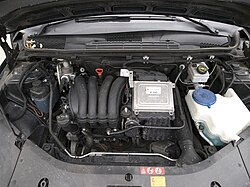Mercedes-Benz M 166 / M 266
| Mercedes Benz | |
|---|---|

|
|
| M 166 | |
| Manufacturer: | Mercedes Benz |
| Production period: | 1997-2005 |
| Working principle: | Otto |
| Design: | Inline four-cylinder |
| Engines: | 1.4 liters (1397 cm³) 1.6 liters (1598 cm³) 1.9 liters (1898 cm³) 2.1 liters (2084 cm³) |
| Previous model: | none |
| Successor: | M 266 |
| Mercedes Benz | |
|---|---|

|
|
| M 266 | |
| Manufacturer: | Mercedes Benz |
| Production period: | 2004–2012 |
| Working principle: | Otto |
| Design: | Inline four-cylinder |
| Engines: | 1.5 liters (1498 cm³) 1.7 liters (1699 cm³) 2.0 liters (2034 cm³) |
| Previous model: | M 166 |
| Successor: | M 270 |
The M 166 is a four- cylinder in-line petrol engine from Mercedes-Benz , which was installed in the A-Class from 1997 and in the Vaneo from 2001 . The M 266 is the largely identical successor model that was installed in the A-Class and B-Class from 2004 .
With the new edition of the A- and B-Class from 2011 and 2012, respectively, these vehicles no longer have a sandwich floor. The successor engine to the M 266 is the M 270 .
The most comparable diesel engines with a similar shape are the OM 668 for the M166 and the OM 640 for the M266 .
technology
The petrol engine is an inline four-cylinder with eight valves and an overhead camshaft (OHC) driven by a timing chain . It has a light-alloy cylinder head and cylinder block, crankshaft with five bearings and electronically controlled fuel injection. It was specially developed for vehicles with the "sandwich" concept. In order to enable a more even weight distribution and the shortest possible front overhang (as well as a short overall length) of the vehicle, the engine is inclined at the front by 60 ° forwards (with its crankshaft center) behind the front axle. The crankcase and oil pan are already partially under the floor of the passenger cell ; in the event of a frontal crash, the engine slides under it to provide enough crumple zone for occupant protection. Only the cylinder head and the maintenance points are easily accessible in the engine compartment.
M 166
| Engine* | designation | Displacement | power | Torque | Remarks |
|---|---|---|---|---|---|
| M 166 E 14 | 166,940 | 1397 cc | 60 kW (82 PS) at 5000 rpm | 130 Nm at 3750 rpm | |
| M 166 E 16 red. | 166.960 red. | 1598 cc | 60 kW (82 PS) at 5000 rpm | 140 Nm at 2500 rpm | A-class with automatic and Vaneo |
| M 166 E 16 | 166.960 | 1598 cc | 75 kW (102 PS) at 5250 rpm | 150 Nm at 4000 rpm | |
| M 166 E 19 | 166,990 | 1898 cc | 92 kW (125 PS) at 5500 rpm | 180 Nm at 4000 rpm | |
| M 166 E 21 | 166.995 | 2084 cc | 103 kW (140 PS) at 5500 rpm | 205 Nm at 4000 rpm | only A class |
Planned versions with turbocharging and over 150 kW (200 hp) were put on hold because of the poorly dimensioned clutch of the A-Class.
As power transmission to the front axle , there were three different transmissions:
- 5-speed manual transmission
- 5-speed automatic converter
- AKS gearbox (automatic clutch system)
In the AKS transmission, sensors on the gear lever control the clutch. The driver only needs to select the gears using the H shift while the clutch is controlled automatically.
M 266
| Engine* | designation | Displacement | power | Torque | Remarks |
|---|---|---|---|---|---|
| M 266 E 15 | M 266.920 | 1498 cc | 70 kW (95 PS) at 5200 rpm | 140 Nm at 3500-4000 rpm | A 150 / A 160 |
| M 266 E 17 | M 266.940 | 1699 cc | 85 kW (116 hp) at 5500 rpm | 155 Nm at 3500-4000 rpm | A 170 / A 180 |
| M 266 E 20 | M 266.960 | 2034 cc | 100 kW (136 hp) at 5500 rpm | 185 Nm at 3500-4000 rpm | |
| M 266 E 20 AL | M 266.980 | 2034 cc | 142 kW (193 hp) at 5000 rpm | 280 Nm at 1800-4850 rpm | only until 2010 |
* Engine designation is coded as follows: M = engine (Otto), series = 3 digits, E = intake manifold injection, displacement = deciliters (rounded), A = exhaust gas turbocharger, L = charge air cooling
As power transmission to the front axle , there were three different transmissions:
- 5-speed manual transmission (from predecessor M 166)
- 6-speed manual transmission
- CVT automatic transmission
swell
- A class manual (MOPF 2001)
- Technical data for the M 166
- Information on the W 168 / M 166 at Elchfans.de